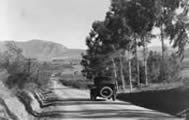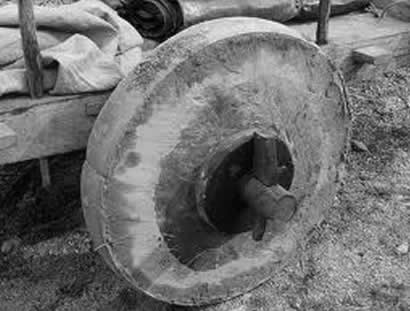Ox Cart Wheel
By Albert Simonson
The ox carts of Cockney Bill’s Rancho Volcan were certainly the best around, according to valuations in the 1850 county assessment roll. This was literally a big paper roll listing things like cattle, forges, houses, etc.
Still, they must have looked primitive like other California ox carts with big solid wood wheels and straight yokes lashed to the oxen’s horns. You can see a well-worn model in Old Town’s Seeley barn.
Three years later, trains of Indian-led ox carts rumbled toward San Diego laden with Viejas grain, mainly barley. Those carts were built at the Valle de las Viejas rancho. They were described as primitive by famed Old Town merchant E.W. Morse, who retired to a place in Alpine near the old cart trail with his wife. She had been the first schoolteacher in the Old Town school. You can still visit that school and see how cute she was, in her very proper way.
I was recently reminded that ox cart design reached its high point already long ago. London’s British Museum has illustrations of carts from 728 BC crammed with refugees and baggage.
The Assyrian king, Tiglath-Pileser III was a total jerk. After conquering and deporting people in what is now southern Iraq, he wanted to gloat some more and impress his palace visitors. So he commissioned a set of panels in bas-relief to adorn his palace walls with images of siege engines, corpses and refugees leaving home in ox carts, rolling toward slavery. His palace was unfinished when he died.
I took some photos of these panels at the museum to show that the ox cart design was already more sophisticated than the California design.
First, the yokes were shoulder-mounted, with ox bows looping around the animal’s neck. The ox could pull harder with its shoulders than with its horns.
Second, the wheels were spoked rather than solid, requiring greater carpentry skill. Generally, Mesopotamian ox carts looked pretty much like recent European ones.
Cockney Bill could have cobbled together any kind of yoke or wheel if he had wanted to – in his free time he was the stage carpenter at the theater in San Diego’s old mission.
I can imagine Cockney Bill or his Indian vaqueros arguing, “Yeah but, our horn-lashed yokes keep the oxen from jerking around at flies and roadside grass, and our solid wheels are stronger and last longer on these rocky roads.”
Blessedly, any such controversy is not our problem. It is now, as they say, history.




